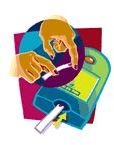Type 2 Diabetes Treatment: Methods of Treatment of Type 2 Diabetes
Treatment for type 2 diabetes starts with controlling the patient’s blood glucose. Patient education and cooperation is essential to this goal. Diabetes patients need to know how their behavior affects their blood sugar. Keeping an eye on blood glucose is a task that affects every aspect of the patient’s life, so treatment for type 2 diabetes is best done through a team that may include the patient’s doctors, dietician, pharmacist, mental health counselor, and/or social worker, as well as their friends and family.
Blood Glucose Monitoring
Because diabetes patients don’t see their doctors every day, blood glucose self-monitoring is an important part of treatment for type 2 diabetes. Several brands of portable, easy-to-use devices for testing blood sugar, called glucometers, are available on the market. The cost of the glucometer and of the single-use lancets and test strips may be covered by the patient’s health insurance.
A portable glucometer makes it convenient for the patient to test their blood glucose at different times of the day. The patient can keep a log of fasting glucose (the blood glucose level first thing in the morning, before eating) and one- or two-hour postprandial (after meal) readings. The log will reveal patterns relating to food choices and timing of meals and exercise, making it easier for the patient to control his or her own blood sugar, and will help the patient’s doctor make treatment decisions.
Type 2 Diabetes Diet
To remain healthy, people with type 2 diabetes must be mindful about their eating habits. The types and amounts of food eaten, as well as the timing of meals, should be planned to help maintain even blood glucose levels. Multiple smaller meals are better than a few large ones, since large meals can cause dramatic spikes and subsequent crashes in blood glucose levels.
The patient’s doctor, dietician, and other members of the treatment team can help the patient with meal planning. Learning how best to eat with diabetes can be difficult, so patient education and support from loved ones are important.
Exercise and Type 2 Diabetes
Physical activity is an important part of treatment for type 2 diabetes. Exercise helps control blood glucose by making the body use some of the excess sugar. Exercise also helps strengthen the heart, bones, muscles, and joints, which may help counteract some of the secondary complications of diabetes, the most serious of which is heart disease. Physical activity can help the patient lost weight, which by itself can improve type 2 diabetes symptoms, and also reduces stress and improves energy.
Drug Treatment for Type 2 Diabetes

Diet and exercise alone may not be enough for some patients to control their blood glucose. A number of prescription drugs are available to help. Most of these are oral medications, which fall into one of several classes. Some patients may require injections of insulin to maintain proper blood glucose levels.
References and Further Information
-
National Diabetes Information Clearinghouse from the United States National Institutes of Health
-
Glucometer image: https://www.fda.gov/cdrh/fdaandyou/issue06.html
-
Diabetes drugs image: https://healthcare411.ahrq.gov/radiocastseg.aspx?id=669&type=seg
